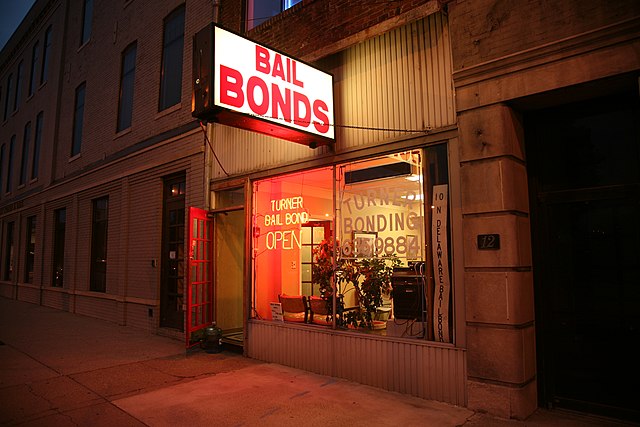By Sandali Gupta
The author is a first-year law student at SLS Noida

INTRODUCTION
Bail is a short-term release of an accused person who is awaiting trial. Bail is the judicial release of an accused charged with a specific crime in exchange for the imposition of a few limitations and the requirement that he remain within the jurisdiction of the court. So, if we look at the history of this concept, we can see that it has a long history. The expression is taken from the old French word ‘bailer,’ which means ‘to present or to supply’.
Bail was created in England for the first time. Since 1948, United Nations Declaration of Human Rights, the notion of bail has been included in the list of human rights. The law fee issued recommendations to parliament in its 41st file, and parliament evaluated and incorporated these proposals in the criminal procedure code of 1973.
The streamlining of bail regulations took the form of simple principles of individual liberty to ensure that they are clearly addressed, as well as a flexible process customised to ensure network comfort through the use of judicial discretion. The strategy appears to be consistent with the bail group’s coverage and purpose.
Provisions as to bail and bonds
Sec. 436: In What Cases Bail To Be Taken
Sec. 436a: Maximum Period For Which An Undertrial Prisoner Can Be Detained
Sec.437: When Bail May Taken In Case Of Non-bailable Offence
Sec.437a: Bail To Require Accused To Appear Before The Next Appellate Court
Sec.438: Directions For Grant Of Bail To Person Apprehending Bail
Sec.439: Special Powers Or High Court And Court Of Session Regarding Bail
Sec.440: Amount Of Bond And Reduction Thereof
Sec.441: Bond Of Accused And Sureties
Sec.441A: Declaration By Sureties
Sec.442: Discharge From Custody
Sec 443: Power to order sufficient bail when that first taken is insufficient.
Sec 444: Discharge of sureties
Sec 445: Deposit instead of recognizance
Sec 446: Procedure when the bond has been forfeited
Sec 446A: Cancellation of bail and bail bond
Sec 447: Procedure in case of insolvency or death of surety or when a bond is forfeited
Sec 448: Bond required from minor
Sec 449: Appeal from orders under Section 446
Sec 450: Power to direct levy of the amount due on certain recognizance
The Code of Criminal Procedure of 1973 has extensive bail provisions. Different types of bail are available under the law :-
- Bail in Bailable offense (Section 436)
- Bail in Non-bailable offense (section 437)
- Anticipatory bail (section 438)
- Ad interim bail
- Bail after conviction (section 389)
- Bail on default (section 167(2))
Sorts Of Bail Available To An Accused Person Seeking Redress
The provisions for bail and bonds were found in sections 436 to 450 of the Criminal Procedure Code. These measures, which are outlined in the statute, provide a rapid solution to the bail provisions.
Section 436 of the Constitution (in what cases bail is to be taken) This phase allows someone accused of any crime, except those that are not bailable, to be released on bail. The following are the bail requirements listed beneath this section:
- He was held or arrested without a warrant by a police officer at a police station.
- He appears or is brought before a courtroom.
- He must be organised to present bail at any moment while in the custody of such officer or at any stage of the proceedings before the courts.
TYPES OF BAIL
- REGULAR: A person who has been arrested or is in police custody is usually granted regular bail. Under CrPC phases 437 and 439, a bail application can be made for ordinary bail.
- INTERIM: This type of bail is provided for a short time and is issued prior to the hearing for the provision of ordinary bail or anticipatory bail.
- ANTICIPATORY: Anticipatory bail is issued under section 438 of the Criminal Procedure Code, either through a consultative court or the High Court. When a person suspects that he or she will be arrested by the police for a non-bailable offence, he or she might make an application for anticipatory bail.
ADVANTAGES OF BAIL
- One can be properly-braced for trial.
- One’s recognition can be preserved.
- One can attend his paintings or task.
- Family bonding and obligations may be maintained.
- Freedom from police torture.
- Freedom from the boredom of hardened criminals.
- Freedom from low hygienic situations of the jail.
- One can meet his endorse whenever.
DISADVANTAGES OF BAIL
- The nation bears the brunt of the charges.
- The accused’s reputation suffers a setback.
- Because individuals have inferior ideas toward the equal, the accused’s family finds it difficult to adapt to society.
CANCELLATION OF BAIL
Bail can be revoked at any moment under section 437 (5) of the CrPC if the accused violates any of the court’s conditions. The kingdom or the party who has been wronged in court might initiate a petition for bail cancellation.
CASE LAWS REGARDING BAIL PROVISIONS
The Madhya Pradesh High Court declared in May 2021 that the District Judiciary is excessively tight coiled in providing bail, and gave the following orders for granting bail to police and judicial officers:
Instructions To Police Regarding Bail
1. When the maximum penalty for an offence is up to 7 years in prison, the accused may not be arrested by the police on the spot unless a specific statute mandates it.
2. Before making an arrest in this situation, the police could write a report explaining why the arrest is necessary: To prevent the accused from committing any additional crimes, or for proper case investigation, or to prevent the accused from causing the disappearance of proof, or based entirely on credible suspicion that the accused might tamper with evidence or prevent a witness from testifying, or based entirely on credible suspicion that the accused might tamper with evidence or prevent a witness from testifying.
3. The State Police are required to structure and bring a checklist of pre-situations that the police must meet under section forty one(1)(b)(ii) of the CrPC when arresting an accused of offences carrying a potential sentence of up to seven years. A copy of the checklist must be provided to the Magistrate, who has the authority to remand the accused to police or judicial custody, together with the remand application.
4. The Magistrate shall be notified within two weeks of the FIR being filed if the police decide not to arrest the suspect. The Superintendent of Police has the authority to extend this time period for reasons that must be documented in writing.
5. If the accused is wanted for questioning, he or she must be issued a note under section 41A CrPC or section 156 CrPC within weeks of the FIR being filed, which might be extended by the Superintendent of Police of the concerned district for motives to be recorded in writing.
6. When the police do not arrest the accused and the accused appears before the police on word under section 41A or phase 160 CrPC and assists the police in the course of the investigation, the police aren’t allowed to arrest the accused unless there are strong reasons to be recorded.
7. Let’s say the cops don’t follow the guidelines outlined above. In that instance, they will be held in contempt of the court’s order, in addition to any other administrative action taken against the offending officer.
Instructions To Judicial Magistrates Regarding Bail
1. The Magistrate should evaluate whether the arrest conducted by the police fits the conditions of phase forty one of the CrPC when exercising remand powers, as stated in paragraph eleven.2 of Arnesh Kumar’s case.
2. As ruled by the Supreme Court in Arnesh Kumar’s case, paragraph 11, the Magistrate must assess if the checklist is available.
3. Suppose the police do not follow Arnesh Kumar’s case’s paragraphs 11.2 and 11.3. In that circumstance, the Magistrate may no longer order the accused’s incarceration and must release him immediately, as the arrest is illegal in and of itself. As a result of the police failing to comply with the criteria of section 41 of the Criminal Procedure Code, his imprisonment would be illegal.
4. According to paragraph 11.4 of Arnesh Kumar’s decision, the Magistrate authorising detention must report his unbiased pleasure and ensure that his pride for similarly remanding the accused is met in his remand order.
5. The Magistrate must also evaluate whether specific reasons for the accused’s arrest have been documented, and whether those reasons are significant enough to justify a reasonable conclusion that one of the conditions for the accused’s continued custody as an undertrial has been met.
6. Failure on the part of the Magistrate to carry out the orders contained herein may result in administrative action being taken against him.
Read More About Bail
Bail provisions under the Code of Criminal Procedure – iPleaders
The Provision of Bail under the Code of Criminal Procedure, 1973 – Important 2021 (lawsuperior.com)
Bail Explained Under Sections 436 to 450 of CrPC (writinglaw.com)
Analysis of Bail provisions under CRPC, SC/ST Act, NDPS and UAPA – LawLex.Org
Read More on LAWOGS
OP-ED: POLICE ROLE AND REFORMS IN INDIA – LAWOGS
Witness Protection in India – LAWOGS
A DIVE INTO THE WORLD OF STEROIDS AND PED’S – LAWOGS
Our new startup
The University Accounts – Promoting Panacea Via Writing (lawogs.co.in)

It’s actually a great and useful piece of info.
I am satisfied that you shared this helpful information with us.
Please keep us informed like this. Thanks for sharing.
I really like your blog.. very nice colors & theme. Did
you make this website yourself or did you hire someone to do it
for you? Plz answer back as I’m looking to create my own blog and would like to know where u got this from.
cheers
Everything published made a great deal of sense.
However, think on this, suppose you wrote a catchier title?
I ain’t saying your content isn’t good, but what if you added a headline to maybe get a
person’s attention? I mean BAIL PROVISION UNDER CrPC – LAWOGS is kinda
vanilla. You ought to look at Yahoo’s home page and see how they create
article titles to grab viewers to click. You might add a video or a picture
or two to get people interested about everything’ve written. Just my opinion, it could bring your blog a little bit more interesting.
Good day! This is my first visit to your blog! We are a collection of volunteers and starting a new initiative in a community in the same niche. Your blog provided us useful information to work on. You have done a marvellous job!